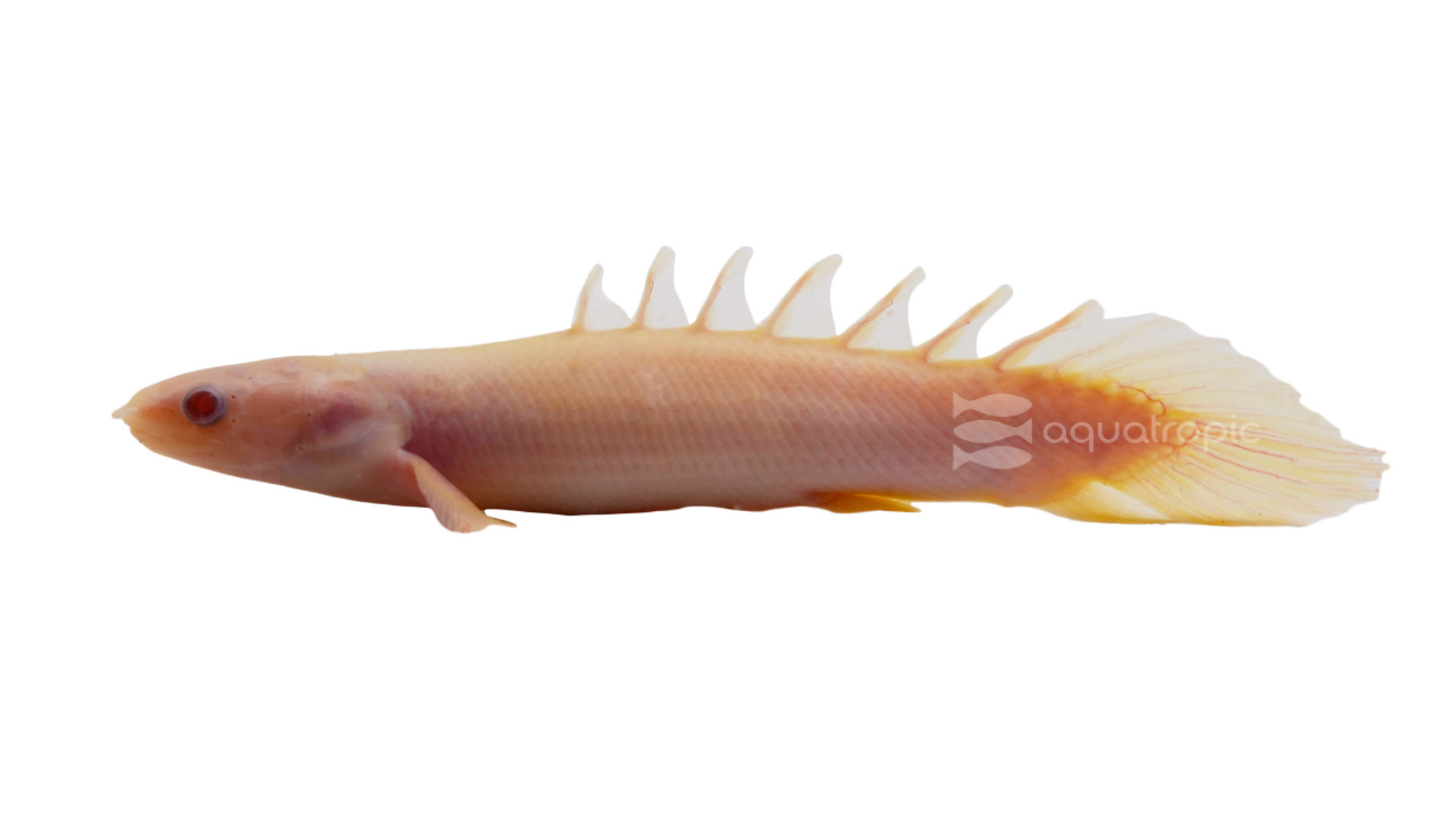The Lil Bichir

Albino Short Body Senegal Bichirs (Polypterus senegalus) are an aquacultured, genetic variant of the popular Senegal Bichir, also sometimes called the Dinosaur Eel. While neither is an Eel per say, we can track their ancestry back millions of years, and it does have a bit of an eel look to it, with its elongated slender body. This body is actually where the division starts, as the Short Body Bichir gets only about half as big as the normal Senegal Bichir at around six inches long. Obviously, most of the Bichirs are usually greyish and thus the Albino portion of the name is the other difference between the two. Care wise, they are pretty much identical, though the Short Body version can be kept in a smaller aquarium over the course of its life.
Albino Senegal Short Body Bichirs can breathe air if they need to, they still have gills but if the mud puddle they live in dries up, they can move to another one (as long as they can get there before they dry up too!) Their native range is all over the African continent. They've been found in Senegal (thus the name), North to Egypt and South to Zambia. They're reports of them even being found in Saharan Oases, though you're much more likely to find one in the backwaters of rivers and swampy areas adjacent to lakes. Wild populations of this fish are very healthy, but nearly all of the fish we see in North America are captive bred, including these, Albinos.
Other than their very unique appearance, the next nicest thing about Bichirs in general is that they are very hardy. Not only are they captive bred and thus accustomed to captive foods, but they naturally come from warm swampy places with poor oxygen levels and higher than average nutrient levels. Building a display for them could be as sparse as a bare bottom tank with clay pots for cover, but a more natural setting would be taking some cover, and open space smooth stones and driftwood. They are an excellent fish for Riparium style displays as well. For those of you who would like to have substrate, make sure it is fine, as Bichirs like to suck their food up, and they need to be able to pass whatever sand they ingest easily.
Albino Short Body Bichirs aren't the world's most active fish, and they don't get that big, and as a result, one could be kept in a tank as small as 20 gallons without much issue. If you're interested in keeping multiples, then 40-gallon breeders, or other tanks with larger footprints would be ideal. Strangely, for a fairly sedate fish that lives in the bottom of the water column, they are still adept at jumping out of aquariums. As such, we recommend a snug fitting lid for any aquarium that has a Bichir. Their ability to breath out of water will save them for a while if they escape, but there is a good chance they will dry out before you get back to them.
In regard to other fish in their displays, Short Body Bichirs can be kept with just about anything that it can't fit in its surprisingly large mouth. Even fish that seem quick enough to get away are consumed a surprising amount of the time. They can be kept with a variety of fish, as they are often ignored by other fish. This being said, the bichir is just about blind, and pretty much defenseless outside of eating its attacker, so watch any new additions for signs of aggression toward your SBB. Bichirs are slow eaters, so make sure their tankmates are picked so that the Bichirs have time to eat their food.
In regard to feeding, P. senegalus is primarily an insectivore in the wild, they eat mostly bugs and crustaceans, with a side dish of fish here and there. These aquacultured Albino Short Body specimens will take just about anything they can fit in their mouths, ours are actively eating the Nutramar Freshwater Complete sinking pellets. They can be slow and messy feeders so tankmates shouldn’t be so boisterous as to prevent them from being able to get some calories.
The Senegal Bichir is one of the easiest species of bichir to spawn in captivity. If you have provided a good habitat, food, and suitable mates, you will probably witness spawning activity! If they actually spawn, they will scatter eggs (usually deposited in/on vegetation in the wild) so offering them a variety of plants or spawning mops may help. The young are really cool looking when they are born as they have external gills initially which makes them almost look like axolotls! The new Bichirs are highly cannibalistic so keep them well fed and separate them as soon as possible. Some people even separate the eggs! In the wild there is some parental care after birth with the young staying close to the adults after birth, though this doesn't seem to be an issue in the home aquarium. Baby Bichirs can take fairly large food too which will aid the home hobbyists in growing them out!
Whether you are an experienced hobbyist looking for another gorgeous fish to add, or a novice looking for a first time Bichir, you can't go wrong with the Albino Short Body Senegal. Give them high quality food, and thoughtful choices for tank mates and you'll get a fascinating living fossil for many years to come! Head to your LFS and ask them to get you one from Aquatropic today!